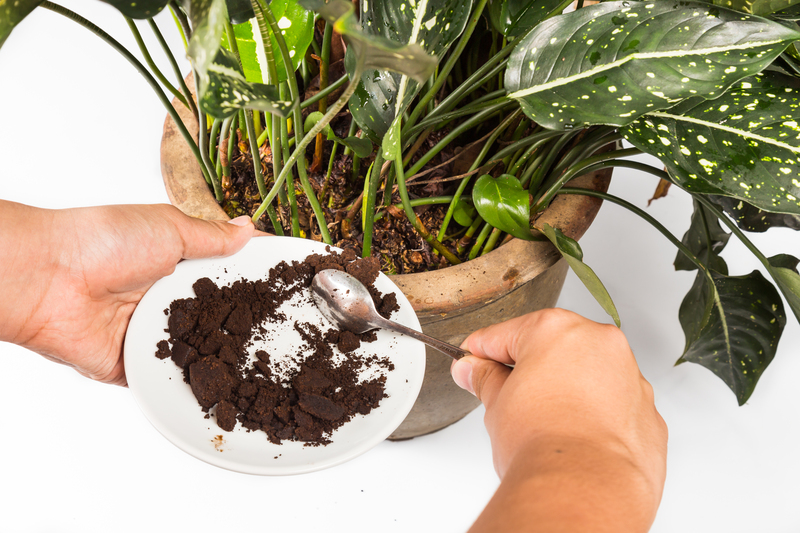Guarding Your Greenery from Winter's Icy Grip
Posted on 24/05/2025
Guarding Your Greenery from Winter's Icy Grip: Your Comprehensive Guide
As the temperature plummets and winter's icy grip takes hold, your garden's lush greenery faces a formidable challenge. Protecting your plants, shrubs, and trees from cold weather hazards is essential if you want to ensure their survival and vibrant resurgence in spring. In this comprehensive article, we'll provide expert strategies for guarding your greenery from winter's icy grip -- helping you weatherproof your garden for the coldest months of the year.

Understanding the Winter Threats Facing Your Greenery
Winter introduces a unique set of challenges for your yard and garden. While some plants are naturally hardy, others require a bit more care and protection. Here are some of the critical threats that winter poses to your beloved greenery:
- Frost Damage: Rapid temperature drops can kill sensitive plant cells, leading to blackened leaves and stunted growth.
- Desiccation: Cold winds strip moisture from leaves and stems, causing them to dry out and become brittle.
- Root Damage: Prolonged freezing temperatures penetrate soil, damaging roots and reducing water absorption.
- Heavy Snow and Ice: Accumulations of snow and ice can cause physical breakage or bend for branches and foliage.
- Salt and Chemical Exposure: De-icing salts from nearby roads or pathways may contaminate soil and damage plant life.
Guarding your garden from the icy grip of winter means understanding these threats and being proactive in your plant care strategies. Let's dive into the best practices for keeping your greenery protected.
Preparing Your Garden: Foundations for Winter Plant Protection
1. Know Your Hardiness Zone and Plant Selection
Before winter even arrives, choose plants suited for your USDA hardiness zone. Native and winter-hardy species are naturally more resistant to freezing temperatures. For tender or exotic plants, plan to provide extra protection.
2. Clean Up and Prune Carefully
Late fall is the ideal time to tidy up garden beds and remove debris. Dead foliage can harbor pests and diseases that become more problematic in winter's damp conditions. Prune away damaged or diseased branches, but avoid heavy pruning, which can encourage tender new growth that won't survive the cold.
3. Deep Watering Before Freezes
Thoroughly water your garden before the ground freezes. Moist soil insulates roots better than dry soil and helps prevent desiccation from winter winds. Pay particular attention to trees and larger shrubs, which may suffer most from moisture loss.
4. Apply Mulch to Insulate
Mulching is one of the primary defenses when guarding your garden against winter's icy grip. Organic mulch, such as straw, bark chips, or shredded leaves, creates a protective barrier, maintaining consistent soil temperatures and retaining moisture.
- Apply a 2-4 inch layer of mulch around the base of trees and shrubs.
- Keep mulch several inches away from trunks to prevent rot.
- Refresh mulch periodically if it becomes compacted or dispersed by wind.
Seasonal Shields: Physical Protection Strategies for Winter Greenery
1. Frost Cloths and Garden Blankets
Specially designed frost cloths or garden blankets offer direct protection from freezing temperatures and frost. These breathable fabrics are draped over vulnerable plants on especially cold nights and removed during the day to allow sunlight and air circulation.
- Use stakes or frames to keep fabric off delicate foliage and prevent crushing.
- Avoid plastic sheeting, which can trap moisture and cause fungal issues.
2. Cloche and Cold Frames
A classic French gardening tool, the cloche, is essentially a mini greenhouse for individual plants. Made of glass or plastic, cloaks can safeguard prized herbs or seedlings from frost. Cold frames operate on the same principle on a larger scale, accommodating rows of veggies or flowers.
3. Windbreaks and Plant Screens
Wind is a notorious culprit when it comes to winter plant injury. Establishing seasonal or permanent windbreaks can mean the difference between a thriving garden and one ravaged by windburn. Options include:
- Temporary: Burlap screens, snow fencing, or even stacked straw bales on the windward side of your garden.
- Permanent: Hedges, dense evergreen shrubs, or latticed panels.
Guarding Evergreen Trees and Shrubs from Winterburn
Evergreens such as pines, spruces, and hollies maintain their foliage year-round but are particularly susceptible to winterburn--leaf or needle browning caused by cold, dry winds. To protect your evergreens:
- Water them deeply before the ground freezes, especially in fall dry spells.
- Mulch heavily around the base to retain soil warmth and moisture.
- Wrap vulnerable species in burlap or use anti-desiccant sprays (specifically designed for evergreens) to reduce moisture loss from leaves and needles.
- Remove snow from limbs gently with a broom to avoid breakage.
Don't prune evergreens in late fall, as this can expose sensitive tissues to desiccation and cold injury.
Strategies for Sensitive and Potted Plants
1. Bring Indoors or Provide Shelter
If you have tropical plants or tender perennials in containers, bring them indoors well before the first predicted frost. Bright, cool spaces such as sunrooms or porches are ideal. If inside isn't an option, position pots in sheltered corners, cluster them for mutual insulation, and wrap them with burlap or bubble wrap around the containers.
2. Raise Pots Off Cold Ground
Pots placed directly on concrete or paving can suffer root damage from the cold. Use pot feet or bricks to lift them slightly, which insulates roots from freezing ground and aids in drainage.
Snow, Ice, and Your Winter Landscape
While a layer of snow can offer some insulation to dormant plants, heavy accumulations may cause physical injury. Here's how you can minimize the risk:
- Remove snow from branches gently to prevent breakage (use an upward sweeping motion, not downward shaking).
- Allow ice to melt naturally--trying to knock it off can break brittle branches.
- For low-growing evergreens, consider protective wooden A-frames or stakes covered in burlap to deflect heavy snow.
Be mindful of where you toss shoveled snow--ice mixed with de-icing salts can significantly harm your garden beds and borders.
Maintaining Lawn Health in Winter
Guarding your greenery from winter's icy grip isn't just about trees and shrubs. Your lawn also needs care:
- Keep grass slightly longer (about 2.5-3 inches) during the final mow before winter to help insulate crowns from the cold.
- Rake and remove fallen leaves that can smother grass and foster mold.
- Limit foot traffic on frozen lawns, as brittle blades are prone to breakage and compaction, causing bare patches in spring.
Organic and Eco-Friendly Methods for Winter Plant Protection
Guarding your landscape from winter's icy reach can be environmentally friendly:
- Use organic mulch like compost, bark, pine needles, or leaf mold to enrich and insulate your soil naturally.
- Opt for burlap or cotton instead of synthetic covers for wind and cold protection.
- Favor biological pest controls instead of chemical sprays to avoid unintended damage during dormancy.
Common Mistakes to Avoid When Protecting Your Garden in Winter
- Neglecting Watering: Plants continue to lose water in winter, especially evergreens. Don't stop watering until the ground freezes.
- Improper Use of Covers: Avoid fleece or plastic directly on plants; they may suffocate or overheat your greenery.
- Over-Mulching: While mulch is beneficial, too thick a layer can suffocate roots and encourage rodents.
- Ignoring Local Climate Trends: Pay attention to weather forecasts and your microclimate--adjust protection according to actual frost dates and wind exposure.
- Too Early/Too Late Protection: Timing is key; put protection in place just before your first hard frost, not weeks earlier.
How to Revive Winter-Damaged Plants in Early Spring
Despite your efforts, sometimes winter's icy grip still leaves some damage. Here's what you can do:
- Wait until all danger of frost is past before pruning dead or damaged plant material--some branches may recover their vigor.
- Feed your garden with a gentle, balanced fertilizer to boost spring recovery.
- Deeply water the soil as temperatures warm, aiding recovery from desiccation.
- Watch for pests and diseases, which may attack weakened plants.
Remember, patience is key--some greenery may rebound more slowly than others.

Winter-Proof Gardening: Planning Ahead for Next Season
Successful winter plant protection relies on preparation, observation, and a little trial and error. Here's a quick end-of-season checklist to guide your future efforts:
- Review which plants thrived and which suffered.
- Take notes on effective techniques and materials used.
- Plan to add more hardy species or adjust placement for sensitive plants.
- Stock up on mulch, burlap, and frost cloths--being ready is half the battle.
Conclusion: Ensuring Lush Growth After Winter's Icy Reign
Guarding your greenery from winter's icy grip is a rewarding process that ensures your plants, lawn, and landscape make a strong comeback when spring arrives. By understanding the risks, implementing preventative measures, and carefully monitoring your garden throughout the cold season, you safeguard not only your investment but also the natural beauty and health of your outdoor spaces.
With diligent care, strategic protection, and a bit of planning, your greenery will emerge from winter's chill ready to flourish -- a true testament to your garden wisdom and stewardship.
```
